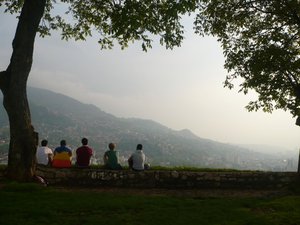Advertisement

 Sarajevo
Sarajevo
me and some Canadians looking out over Sarajevo from a hilltopAfter more exploration it seems that my initial impression of Sarajevo as a run-down post-Communist city was somewhat exaggerated: the outskirts that I passed through on my way to the hostel from the airport were like this, but the Old Town (where my hostel is located) is much bigger than I first realized, and is really beautiful. Furthermore, there are significant areas which are very modern, with a 100% Western feel: the high street could easily be in Paris or London (if it weren't for the mountains in the background); the parliament building is very modern, with impressive water features outside; and I visited the nicest, cleanest, most modern shopping mall that I've ever seen. It's really evident to me that Sarajevo is on its way to economic rebirth, with a lot of new construction and a growing tourism industry.
Yesterday I visited the Historical Museum, which had a very informative and poignant section about life in Sarajevo during the war of 1992-95, as well as a really interesting section on the early history of Bosnia & Herzegovina. However, the entire communist period of 1946-91 was conspicuously gleaned over; as such, there was little real explanation of the root causes of the conflict in the '90s. After visiting the museum I took a guided tour of the city, which again focused greatly on the 1992-95 war, with little mention of communist Yugoslavia. Interestingly, when the guide (who was a history student in his 20s) did talk of the communist era, he spoke of it in an unerringly positive light. I think in comparison to the tragic conflict that followed its dissolution, life in Bosnia under the communist régime seems easy and prosperous. As part of the guided tour we visited a remaining segment of a secret underground tunnel built by the people of Sarajevo to bring supplies into the city when it was under siege. Although it's evident that the civilian population of Sarajevo suffered immensely and unjustly during the war, I couldn't help but feel that all the information I received was somewhat biased against the Serbs: no mention was made of the Mujahideen or of any aggression by the Bosniaks (Bosnian Muslims).
Aside from the museum and the guided tour, I also visited the spot where Archduke Franz Ferdinand was assassinated in 1914, indirectly triggering the outbreak of World War 1. According to the tour guide, the assassin Gavrilo Princip had been unequivocally considered a national hero, and still is viewed positively by many Serbs.
However my favourite thing that I've visited in Sarajevo so far is a hill just on the edge of the Old Town, perhaps a 20 minute walk from my hostel. From there one has incredible views across the whole city and the surrounding mountains: I've been there by day and by night, and both are equally impressive. It's a shame I couldn't take any pictures of this view, but some Canadians I was with took a lot of photos, so hopefully I'll be able to get hold of them at a later date.
I've decided to leave Sarajevo a day earlier than originally planned, getting a 7am train to Mostar, where I intend to spend one night before probably heading into Montenegro. All the travellers I've met tell me that Montenegro is definitely worth visiting, and that Croatia doesn't warrant quite as much time as I'd been planning to give it.
Advertisement
Tot: 0.064s; Tpl: 0.01s; cc: 6; qc: 44; dbt: 0.033s; 1; m:domysql w:travelblog (10.17.0.13); sld: 1;
; mem: 1.1mb

 Sarajevo
Sarajevo